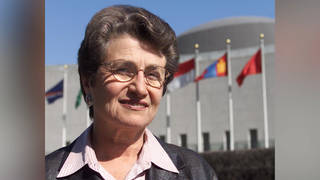
On Tuesday, the psychologist identified as the “architect” of the CIA’s torture program testified for the first time to the war court at Guantánamo Bay. James Mitchell was in the courtroom for a pretrial hearing for five 9/11 suspects who had been subject to torture, euphemistically called “enhanced interrogation techniques.” Mitchell and his partner, Dr. Bruce Jessen, were paid $81 million to help design the CIA’s torture methods, including some of the agency’s most abusive tactics. The pair had no prior experience in interrogation. At the hearing, Mitchell reportedly told defense lawyers he only came to Guantánamo to testify in person before the families of the 9/11 victims, and at one point told the torture survivors, “You folks have been saying untrue and malicious things about me and Dr. Jessen for years.” In 2014, James Mitchell confirmed to Vice News that he personally waterboarded alleged 9/11 mastermind Khalid Sheikh Mohammed. Mitchell also reportedly waterboarded Abu Zubaydah at a secret CIA black site in Thailand. Earlier this month, protesters marked the 18th anniversary of Guantánamo by donning orange jumpsuits and lining up in front of the White House. They later held a mock funeral at Trump International Hotel for those who died at the U.S. detention facility. We speak with Baher Azmy, legal director of the Center for Constitutional Rights.
Transcript
AMY GOODMAN: We’re going to turn to another trial right now. This is Democracy Now! I’m Amy Goodman, with Juan González. Guantánamo.
JUAN GONZÁLEZ: Well, on Tuesday, the psychologist identified as the “architect” of the CIA’s torture program testified for the first time at the military court at Guantánamo Bay. James Mitchell was in the courtroom for a pretrial hearing for five 9/11 suspects who had been subject to torture, euphemistically called “enhanced interrogation techniques.” Mitchell and his partner, Dr. Bruce Jessen, were paid $81 million to help design the CIA’s torture methods, including some of the most abusive tactics. The pair had no prior experience in interrogation.
AMY GOODMAN: So, on Tuesday, Dr. Mitchell reportedly told defense lawyers he only came to Guantánamo to testify in person before the families of the 9/11 victims, and at one point told the torture survivors, the prisoners, quote — I mean, he was sitting right next to the men he tortured — “You folks have been saying untrue and malicious things about me and Dr. Jessen for years.”
In 2014, Dr. Mitchell confirmed he personally waterboarded Khalid Sheikh Mohammed, who was waterboarded 183 times in March of 2003. Mitchell told Vice News, “Yes, I waterboarded KSM. I was part of a larger team that waterboarded a small number of detainees.” Dr. Mitchell also reportedly waterboarded Abu Zubaydah at a secret CIA black site in Thailand.
Well, earlier this month, protesters marked the 18th anniversary of Guantánamo by donning orange jumpsuits and lining up in front of the White House. They later held a mock funeral at Trump International Hotel for those who died at the U.S. prison in Guantánamo.
For more, we’re going back to Baher Azmy, the legal director of the Center for Constitutional Rights. I mean, this is an incredible scene in Guantánamo, where you have the torturer and the men he tortured.
BAHER AZMY: Yeah, I think, at least in that way, this is a kind of soft form of accountability, because, at a fundamental level, Mitchell and his partner, Jessen, have not faced real accountability for the war crimes they generated. And another soft form of accountability was the civil lawsuit brought by victims of his program, in a lawsuit brought by the ACLU, that resulted in undisclosed damages.
But I think, you know, it’s interesting that we’re talking about these two trials together — military commissions and the Senate trial — because they are, in a sense, both show trials. The military commissions process was generated instead of a traditional Article III criminal trial, in order to suppress the truth, as is the Senate version of the trial, in order to repress accountability for war crimes and, in the Senate trial, repress accountability for an abuse of power. So, this is — like the Senate trial, there are small possibilities, small windows, to pull out information. But, more fundamentally, we have to ask bigger questions about the CIA torture program and the FBI’s involvement, as well.
JUAN GONZÁLEZ: And what are your hopes in terms of new information coming out of this trial in terms — and of the aggressiveness of the prosecutors — I mean, the defense attorneys, in being able to get new information out on this?
BAHER AZMY: Well, I think, just sort of most concretely, the defense lawyers want to prevent their clients from being executed, which is the very purpose of these trials. And then I think they seek to learn more information about how, despite having been interrogated again by the FBI, the so-called clean teams in 2007 or 2009, their clients are still suffering the effects of torture, and also to find more information about FBI involvement with CIA interrogations prior. But there are other things that can be done. These individuals can be prosecuted for war crimes, Mitchell and Jessen. There is a Senate select report on torture that is yet to be declassified. This is, you know, a small piece of accountability. But as I said before, much more needs to be done.
AMY GOODMAN: Explain. I mean, this was such a major issue for years. The American Psychological Association, their whole leadership was toppled because they were participating with the CIA in this torture program. And Dr. James Mitchell was a psychologist who participated in this, what they called EIT, enhanced interrogation technique, which was outright torture.
BAHER AZMY: Outright torture indeed. I mean, he reverse-engineered psychological principles designed to help people.
AMY GOODMAN: Explain what SERE was.
BAHER AZMY: Well, SERE is a training program that U.S. officers were subjected to in order to resist torture. And he took concepts, psychological concepts, like learned helplessness, that were developed to understand the behavior of animals who were subject to repeated controlling and coercion, and engineered them to induce, in the CIA’s words, debility, despair and dread in detainees, so they became helpless upon their interrogators and would confess — in many cases, obviously, falsely.
AMY GOODMAN: And soldiers were trained in it, right? Survival, evasion, resistance and escape.
BAHER AZMY: Right, right. That’s the acronym, yeah.
AMY GOODMAN: But then they reverse-engineered it to do this to prisoners.
BAHER AZMY: Yes. And SERE was designed, emerging out of the Korean War, because U.S. soldiers were subjected to severe forms of psychological and physical torture by their captors, the sort of Chinese communists. And so, these techniques were designed to instill resistance in U.S. soldiers, should they be subject to this again. But the CIA used these techniques not as a training for defense, but to deploy them on human beings and destroy them.
JUAN GONZÁLEZ: And the five men who are on trial, they were screened off from the rest of the courtroom, weren’t they? As the description I’ve read. What is the possibility of the information that they gave being deemed inadmissible because as a result of their torture?
BAHER AZMY: Yeah, that’s what they’re seeking, both to exclude their so-called clean confessions that were done after CIA torture, because they’re a product of the trauma from the original torture, and also as a possibility to reduce their sentence and avoid the death penalty, because they were subject to these horrendous war crimes systematically.
AMY GOODMAN: Will they also be questioned about their tactics in black sites, including the one in Thailand? That particular secret prison in Thailand for a time was run by, what, the current CIA director, Gina Haspel.
BAHER AZMY: That’s right, yeah. And, I mean, it remains to be seen how much of this information will — that the defense lawyers will be able to ask, and then how much of it will be permitted to be public as opposed to being kept classified.
AMY GOODMAN: President Obama promised that men like James Mitchell would not be prosecuted. Do you ever see them in the dock being questioned?
BAHER AZMY: Well, I mean, I think the — as we know from other countries, these sort of forms of accountability often take an incredibly long time. And it requires pressure from a lot of places, including transparency around the program and the release of the Senate torture report, I think new leadership in the CIA, for sure, and in the Senate and the House and in the White House.
AMY GOODMAN: Well, I want to thank you, Baher Azmy, legal director of the Center for Constitutional Rights, as well as Vince Warren of the Center for Constitutional Rights.
When we come back, we go to Brazil. The Pulitzer Prize-winning journalist Glenn Greenwald has had a criminal complaint filed against him. Will he be indicted? Will he go to prison? Stay with us.
[break]
AMY GOODMAN: “Gemini” by the jazz saxophonist and composer Jimmy Heath, who died Sunday at the age of 93.











Media Options